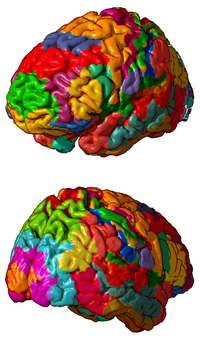
Photo from wikipedia
The goal of this study is to identify the cortical area maximally active over the primary sensorimotor cortex (SM1) and characterize the cortical encoding for force production by wrist muscles… Click to show full abstract
The goal of this study is to identify the cortical area maximally active over the primary sensorimotor cortex (SM1) and characterize the cortical encoding for force production by wrist muscles in the human brain. The technique of functional near-infrared spectroscopy (fNIRS) was used to continuously monitor the changes in hemoglobin concentrations from the left hemisphere during isometric contractions of wrist flexion muscles over a broad range of load forces (0 ∼ 8 kgf) on the right hand. As previously shown in primate studies, this action produced hemodynamic activity predominantly in the wrist area localized dorsally to the finger region over SM1 and the hemodynamic response was systematically related to the level of load intensity. The coding scheme for force production in terms of hemodynamic signals was characterized defining eight trajectory parameters (four for amplitude coding and four for temporal coding) and analyzed for the area maximally activated over SM1. The trajectory parameter representing the oxygenated hemoglobin concentration change at the end of motor task (amplitude coding) and the timing of maximum change in oxygenated hemoglobin concentration (temporal coding) was most strongly correlated with the load variation in a superliner manner. All these results indicate the applicability of fNIRS to monitor and decode cortical activity that is correlated with low-level motor control such as isometric muscle contractions. This study may provide not only insights into cortical neural control of muscle force but also predictors of muscle force in clinical diagnostics and neural interfaces for the human brain.
Journal Title: Behavioural Brain Research
Year Published: 2021
Link to full text (if available)
Share on Social Media: Sign Up to like & get
recommendations!